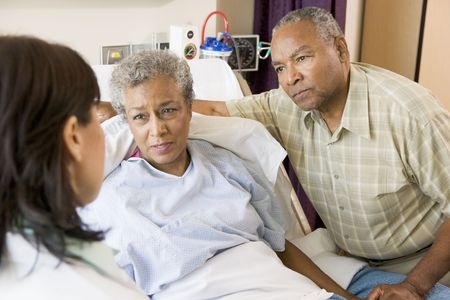By William “Bill” Hurst, Wrongful Death Attorney
A mother of three wakes up one morning and notices a lump on her neck that she hasn’t seen before. Fearing for the worst the woman rushes to the hospital and waits patiently to see a doctor. After hours of waiting she is finally seen and finds out she has Cancer. The doctor tells her this specific type of Cancer is extremely dangerous and that she only has a 45% chance of survival. The next day the woman begins treatment and nine months later she is Cancer free, she survived.
What if that doctor had negligently misdiagnosed her and she went the next four months untreated before being told she now only has a 10% chance of survival. What if she passes away having gone undiagnosed for four months and having her chance of survival decrease by 35%. Unfortunately situations such as this one occur and up until roughly twenty years ago, this woman’s family would not have received any monetary compensation for her loss as it isn’t a literal wrongful death situation, which was the only option available. Today, she (or her family if she had passed away) would have a claim for “Lost Chance of Survival/Recovery”.
“Lost Chance of Survival” was first recognized as a claim in a 1966 Federal Case, Hicks v. United States.1 In these cases the plaintiff’s claim is not that the doctor’s negligence caused his/her ultimate death, but that it lessened the chance to survive or be cured.
Indiana’s First Recognition Of A Claim For The Loss of Chance Of Survival
Indiana first recognized a claim for Loss of Chance of Survival due to Medical Malpractice in the 1995 case Mayhue v. Sparkman.2 Much like the earlier hypothetical this case involved a woman who was misdiagnosed as having an infection when in reality she had Cancer. The Cancer was not discovered until she passed away because her doctor assumed it was an infection and never ordered the proper tests. Medical experts who testified in the 
In this case the court recognized that a doctor should not be allowed to avoid liability for his/her negligence which resulted in a patient being misdiagnosed and later dying simply because the patient had less than a 50% chance of living even if properly diagnosed. After analyzing the approaches other states had taken in deciding these types of cases the Indiana Supreme Court decided it best to follow what was called the “§ 323” approach. This approach was based on a Restatement (Second) of Torts §3233 which stated:
“One who undertakes, gratuitously or for consideration, to render services to another which he should recognize as necessary for the protection of the other’s person or things, is subject to liability to the other for physical harm resulting from his failure to exercise reasonable care to perform his undertaking, if:
(a) His failure to exercise such care increases the risk of harm, or;
(b) The harm is suffered because of the other’s reliance upon the undertaking.
What this meant is that if a doctor offers aid he must not act negligently and if he does he may be held accountable for the damage his negligence causes, even if that damage is only an increased risk of harm or lost chance at survival/recovery. While the court did not specifically recognize pure “loss of chance” as a claim in this case it did open the door for it to be recognized later by making it clear that doctor’s should not be able to get away with being negligent by claiming the patient was likely going to die anyway.
The Claim Expands To Include Loss of Chance of Recovery
After the Mayhue case it was clear that a doctor could be held liable for their negligence when it resulted in the death of a patient even if the patient had less than a 50% chance of living to begin with. But what if the patient doesn’t pass away? That question was answered by Alexander v. Scheid4 in 2000 when the court officially recognized “Loss of Chance” as a claim. The court in this case ruled that a reduced chance of survival or decrease in life expectancy as a result of a doctor’s negligence was a compensable injury even if the patient has not died or the end result is not yet known. This seemingly opens the door for people who are misdiagnosed and as a result have a much lower chance of survival, but who ultimately recover to collect damages for the doctor’s negligence. The court in this case also addressed valuation, but the next cases did a much better job of illustrating how these injuries should be valued and compensated.
Two other cases tried in 2000, Cahoon v. Cummings5 and Smith v. Washington6 both addressed how to value what the damages in a “Loss of Chance” cases. Both cases agreed that the damage award should be “proportional to the increased risk attributable to the defendant’s negligent act or omission.” These courts determined the correct way to calculate damages in these cases was to determine what amount would be “ordinarily allowed” in a wrongful death case, then take the probability that the patient would have survived had the doctor not been negligent and subtract the survival chance after the doctor was negligent and multiple that by the amount “ordinarily allowed” in a wrongful death claim. Example:
Loss of Chance Damages = WD x (PWODN – PWDN)
WD – Wrongful Death Amount
PWODN – Probability patient would have survived without doctor’s negligence
PWDN – Probability patient survives after doctor’s negligence
As you can see Indiana now recognizes claims where a person has suffered a “loss of chance” due to a doctor’s negligence regardless of the outcome. This includes cases such as the one above where the party had died as well as those where a party has not died, but did suffer a “loss of chance” due to the doctor’s negligence. If you or a loved one has suffered a “loss of chance” due to a doctor’s negligence it is important that you seek an experience attorney immediately.
Citations:
1 Hicks v. United States, 22 Ill. 368 F.2d 626 (4th Cir. 1966)
2 Mayhue v. Sparkman, 653 N.E.2d 1384 (Ind. 1995)
3 Restatement (Second) Torts § 323
4 Alexander v. Sheid, 726 N.E.2d 272 (Ind. 2000)
5 Cahoon v. Cummings, 734 N.E.2d 535 (Ind. 2000)
6 Smith v. Washington, 734 N.E.2d 548 (Ind. 2000)





